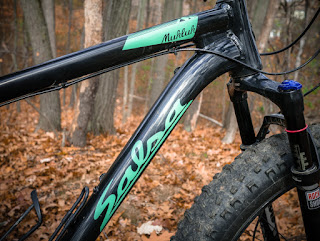Looks like winter finally arrived. This morning commute was quite a mess. The snowfall started at night and continued through the morning and most of the day. Unfortunately, it's just too warm outside and what we've got was not a fresh blanket of white, fluffy snow we all (?) like, but a muddy mess, heavy and wet.
Despite all that, I decided to ride my bike to work and leave the car behind. Too bad I quickly had to abandon safety of the Minuteman Bikeway as it wasn't cleared of snow at all and riding through the sticky slush on my Schwinn proved to be too difficult. If only I had a fatbike... well, that's another story.
Because main roads were plowed and relatively snow free, this meant going back to vehicular cycling, i.e. "sharing" road with cars. Usually, this "sharing" in the weather like today looks like this - you ride as close to the curb as you feel is safe and try not to skid on any patches of black ice, while motorists pass too close to you splashing you all the time with muddy slush from the road.
I felt a bit like Yehuda this morning. It's not fun to get splashed by passing cars every minute of your commute. (Source: yehudamoon.com)
Enough complaining. Time for the year end summary. The passing 2015 was a pretty interesting year, from bicycling standpoint, at least.
It all started with sub-zero temperatures and a big "Snowmageddon". It was supposed to be a big snowfall but happened to be a regular one. Regular, in Boston terms, means something like 2 feet of snow overnight, of course. Nevertheless, the last winter season was truly record breaking with combined 2.8m (or 9 feet) of snowfall. I remember digging a tunnel in snow to my front door and some cyclists did the same in order to access the bike path in Medford.
The mountains of snow we had last winter created a completely new problem for me - with a place to park my bike. It was actually easier to park a car (requiring more space) than a much smaller bicycle. All because parking lots get plowed in winter here, but bike racks don't.
All that was in January and February. Then came March... and the situation got even worse. But no matter. Spring finally arrived and I celebrated it with the purchase of a new bag - Racktime ShoulderIt.
In May, I finally completed rebuilding my Xtracycle Edgerunner into "Big Eddie" - or what I call the electric version of it. Electric bicycles have probably the same number of fans as opponents. If you don't like them, I'm just going to nod my head and admit - yes, it's like cheating, yes - they are a bit like motorcycles. But if you were trying to haul two kids and 4 bags of groceries up a 10% grade, believe me - you would WANT that electric motor on you bike.
In June, the new Copenhagenize Index was published and we have even seen some American cities on the list as well. Sign of changes? Not in Boston though. We would likely be classified around place 200.
In the same month, thinking about my kids, I put together a list of better-than-Wallmart-junk children bicycles. If you happen to think about a new bike for your little buggers, take a peek.
With the arrival of warmer weather, I started riding my bike more and discovered some new places around Boston - MIT Haystack Observatory and Fruitlands. Then I finally found some time for a little longer ride - a 2-day "mini tour" to York in Maine and back. To complete that busy cycling week, I rode my bike to Cape Cod, but from the other end, making a landing by ferry.
Early fall, here in Boston we were reintroduced to the concept of tactical urbanism thanks to the hard work of Johathan and other folks, who decided not to wait until city governors finally do something about bicycling infrastructure and took the matter in their own hands - by planting hundreds of cones to separate bike lanes from a fast-moving car traffic. Even if not all cones stayed in place for too long, results were important and eye-opening.
Towards the end of the year, I swapped the lightweight road tires on my bike back to wider cross ones and went back to the roots - exploring dirt roads and trails in my area, such as the Western Greenway. Not having enough, I managed to test ride the newest Salsa Mukluk as well.
FInally, it was the Christmas time and while my wishlist is, well... just wishful thinking at this point, I will try my best to make some of these wishes come true. In 2016 or later.




























